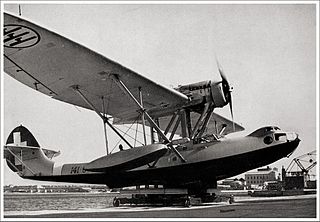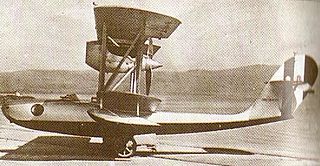Related Research Articles

The CANT Z.1007 Alcione (Kingfisher) was an Italian three-engined medium bomber, with wooden structure. Designed by Filippo Zappata, who also designed the CANT Z.506 it had "excellent flying characteristics and good stability" and was regarded by some as "the best Italian bomber of World War II" although its wooden structure was easily damaged by the climate, as experienced in North Africa and in Russia. It was used by the Italian Regia Aeronautica, Italian Co-Belligerent Air Force, Aeronautica Nazionale Repubblicana and Luftwaffe during World War II.

The CANT Z.501 Gabbiano was a high-wing central-hull flying boat, with two outboard floats. It was powered by a single engine installed in the middle of the main-plane and had a crew of 4–5 men. It served with the Italian Regia Aeronautica during World War II, as a reconnaissance aeroplane. During its debut in 1934, it set a world distance record. It was obsolete by 1940, but was still used throughout World War II, suffering many losses. A few remained in service until 1949.

The CANT Z.506 Airone was a triple-engine floatplane produced by CANT from 1935. It served as a transport and postal aircraft with the Italian airline "Ala Littoria". It established 10 world records in 1936 and another 10 in 1937. During World War II it was used as a reconnaissance aircraft, bomber and air-sea rescue plane, by the Italian Regia Aeronautica and Regia Marina, Aeronautica Cobelligerante del Sud, Aeronautica Nazionale Repubblicana and the Luftwaffe. The military version revealed itself to be one of the best floatplanes ever built. Despite its wooden structure it was able to operate in very rough seas. A number of Z.506S air-sea rescue aircraft remained in service until 1959.

The Savoia-Marchetti S.74 was a four-engine airliner developed by Savoia-Marchetti for Ala Littoria.

The CANT Z.511 was a four-engine long-range seaplane designed by Filippo Zappata of the "Cantieri Riuniti dell'Adriatico" (CRDA) company. Originally designed for the Central and South Atlantic passenger routes, it was later adapted as a military transport and special raider.

The Breda Ba.25 was an Italian two-seat biplane trainer designed and built by the Breda company. It was the most widely used Italian basic trainer of the 1930s.

The Meridionali Ro.37 Lince was a two-seater Italian reconnaissance biplane, a product of the Industrie Meccaniche Aeronautiche Meridionali (IMAM) company. It appeared in 1934 and had a composite structure of wood and metal. The aeroplane first saw operational duty in the Second Italo-Ethiopian War (1935–1936) and Spanish Civil War (1936–1939), and during the Second World War it saw duty on almost all fronts, except for Russia and the English Channel. It followed the Ro.1 as the main reconnaissance aircraft for the Italian Army.

The IMAM Ro.43 was an Italian reconnaissance single float seaplane, serving in the Regia Marina between 1935 and 1943.

The CRDA CANT Z.1018 Leone (Lion) was an Italian medium bomber of the 1940s.

The IMAM Ro.51 was an Italian fighter aircraft that first flew in 1937. It was designed for the 1936 new fighter contest for the Regia Aeronautica, with practically all the Italian aircraft builders involved.

The CANT 25 was an Italian shipboard single-seat biplane flying boat fighter that entered service with the Regia Aeronautica in 1931.

The Caproni CH.1 was a single-seat biplane fighter, a single example of which was produced as a prototype in Italy in 1935.

The CANT Z.515 was a twin engine monoplane floatplane designed and built for maritime reconnaissance in Italy at the start of World War II. It did not go into service.
The Caproni Ca.131 was a prototype for a large aircraft built in Italy in 1934, intended for use as either a bomber or airliner. It was a conventional low-wing cantilever monoplane, powered by a radial engine on each wing and in the nose. The main undercarriage was housed within large streamlined spats. Configured as an airliner, it would have seated 17 passengers.
The Caproni Ca.134 was a biplane reconnaissance aircraft built by the Italian company Caproni in the 1930s.

The CANT Z.516 was a three engine monoplane floatplane designed in Italy at the start of World War II. It did not go into service.

The CANT Z.505 was a prototype trimotor transport floatplane built by CANT in the 1930s.
The Macchi M.C.77 was a reconnaissance bomber flying boat built by Macchi in the thirties and remained at the prototype stage.
The Caproni Ca.146 was a high-wing reconnaissance aircraft built by Caproni in the mid-1930s.
The IMAM Ro.26, sometimes called the Romeo Ro.26, was a single-engine biplane trainer aircraft produced by the Italian aeronautical company IMAM in the early 1930s. Only one example was built.
References
- 1 2 3 4 "Muca - Museo della Cantieristica a Monfalcone - CANT-Z. 504 Idrovolante imbarcato da ricognizione". www.mucamonfalcone.it (in Italian). Trieste. Retrieved 23 January 2019.
- ↑ "CANT Z.504". Airwar (in Russian). Moscow. Retrieved 23 January 2019.